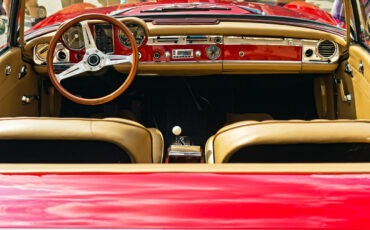
Restoring a classic car is a dream for many automotive enthusiasts. Whether it’s bringing an old beauty back to life or giving a neglected relic a second chance on the road, classic car restoration can be a rewarding—and sometimes challenging—hobby. But don’t worry! If you’re new to the world of classic car restoration, this guide will walk you through every step of the process. From planning to polishing, we’ve got you covered.
Why Restore a Classic Car?
Restoring a classic car can be more than just a hobby; it’s a passion project. Here’s why you might want to dive into it:
– Preserving history: Classic cars are a window into the past, and restoring them helps keep that history alive.
– Personal satisfaction: There’s something incredibly rewarding about bringing a car back from the dead and seeing it shine like it did decades ago.
– Investment potential: A well-restored classic car can appreciate in value, making it a smart investment over time.
– Creative expression: Restoration allows you to put your own stamp on a car, whether you’re keeping it original or adding your own custom touches. We believe in preserving cars in their most original condition.
Step 1: Choosing the Right Car to Restore
Not all cars are created equal when it comes to restoration. For beginners, it’s important to pick a project that won’t overwhelm you.

– Set a Budget: Know how much you’re willing to spend. Restoration costs can add up quickly, so be realistic about your financial commitment.
– Research the Model: Some cars are easier to restore because parts are more readily available, and there’s a large community of enthusiasts who can offer advice. Start with popular models like a, Fiat 500 / 600, a VW Beetle or Ford Mustang (for our american readers).
– Check the Condition: The car’s condition is crucial. Look for a project car with minimal rust and a solid frame. Mechanical issues are easier (and cheaper) to fix than extensive bodywork. Also, Check the VIN to get a clearer picture of the car’s history and avoid hidden surprises. Using a trusted platform like GoodCar can provide detailed vehicle history reports to help you make a more informed decision.
💡 Pro Tip: Avoid rare models for your first project. Parts can be difficult (and expensive) to source, making the restoration more challenging. You can easily find affordable project cars at subito.it if you are looking for a Fiat model. Also, you can restore a Fiat fuoriserie (those were based on popular Fiat models such as 600 or 850) which spare parts are not that hard to find and cheap.
Step 2: Planning Your Restoration Project
Before diving into the physical work, you’ll need a solid plan.

– Decide on the Scope: Are you aiming for a full frame; off restoration or just a mechanical refresh? A full restoration involves disassembling the entire car, while smaller projects focus on specific areas like the engine or interior.
– Source Parts: Make a list of all the parts you’ll need, and start sourcing them. Look for online forums, junkyards, and classic car shows for affordable parts.
– Gather Tools: A good restoration requires the right tools. At a minimum, you’ll need wrenches, jacks, a compressor, a sandblaster, and various hand tools. Don’t forget protective gear like gloves and safety goggles.
– Do researching: Restoring classic cars requires thorough research to ensure authenticity. Start by gathering detailed information about the car’s original specifications, using historic photos for reference. These photos are key to identifying factory paint colors, trim, badges, and interior finishes. Car manuals, vintage magazines, and online databases can provide additional guidance. Pay attention to era-specific details, such as materials and parts, to accurately match the car’s original condition. Networking with other enthusiasts or joining restoration forums can also help uncover rare information. Proper research ensures a restoration true to the car’s factory state.
💡 Pro Tip: Join classic car forums or clubs; they’re a great place to get advice and find hard-to-source parts.
Step 3: Stripping the Car Down
Once you have a plan and your tools ready, it’s time to strip the car down to its skeleton.

– Remove the Interior: Start by carefully removing seats, carpets, dashboards, and any other interior components. Be sure to label everything for reassembly.
– Take Off the Exterior Panels: Remove doors, fenders, hood, and trunk. If the car is going to be repainted or needs significant bodywork, take note of any dents or rust spots.
– Engine and Transmission Removal: For a full restoration, you’ll want to pull out the engine and transmission. This gives you full access to the undercarriage and allows you to restore both the body and the mechanical parts.
💡 Pro Tip: Take lots of photos during disassembly. It’ll make reassembly much easier!
Step 4: Bodywork and Rust Repair
Rust is the classic car restorer’s worst enemy. Dealing with it properly is key to a successful restoration.

– Look for the original paintcolor. If repainted, you can find the original color under the current paint layer.
– Inspect for Rust: Carefully check the entire frame and body panels for rust. Surface rust can often be sanded away, but if the rust is deep, you may need to cut and weld new metal patches.
– Dent Removal: Minor dents can be worked out with a hammer and dolly set. Larger dents may require professional help.
– Primer and Paint: After the body is smoothed out, apply a primer coat to protect the metal from future rust. Once primed, it’s time for the fun part: painting! Choose an original color Search for the color code.
💡 Pro Tip: Consider having a professional shop do the painting unless you’re experienced. Paint quality is crucial for resale value and aesthetics.
Step 5: Restoring Mechanical Components
Now it’s time to bring the heart of your car; the engine and mechanical systems, back to life.

– Rebuild the Engine: Depending on the engine’s condition, you may need a full rebuild. This involves cleaning, re-machining, and replacing key components like the pistons and valves.
– Transmission and Suspension: Overhaul the transmission and check the suspension system for worn components. Replace shocks, springs, and bushings as needed.
– Brake and Electrical System: Make sure to install a new braking system and update the car’s electrical wiring. Faulty wiring is common in old cars and can be dangerous.
💡 Pro Tip: If you’re not confident in rebuilding the engine, don’t hesitate to enlist professional help. Getting it wrong can lead to major issues down the road.
Step 6: Tackling the Windscreen: A Hidden Challenge
A common issue in classic car restoration that many beginners overlook is the windscreen seals. If your car’s windscreen is cracked or broken, finding a replacement can be a daunting (and expensive) task. Windscreen seals are hard to find, especially for rarer models, and reproducing them can be extremely costly.

– Inspect the Windscreen: Before removing the windscreen, carefully check for any cracks or signs of damage.
– Find Replacement Seals: When replacing the windscreen, make sure to source high-quality replacement seals. These are crucial for preventing leaks and ensuring the structural integrity of the windscreen.
💡 Pro Tip: Look for specialist suppliers or consider reproduction services if you can’t find an original part, but be prepared for higher costs. Check also ebay.
Step 7: Interior Restoration and Upholstery
When it comes to restoring the interior, quality upholstery is key to giving your car that polished, authentic look.

– Seats and Trim: Replace worn or torn upholstery with fresh materials. For Italian cars, finding the right upholstery shop can be challenging, but look no further than Fratelli Maieli near Mantua, Italy. They are renowned for their craftsmanship and expertise in Italian classics.
– Dashboard and Carpet: Restore or replace cracked dashboards and worn carpets to complete the interior overhaul.
💡 Pro Tip: Fratelli Maieli specializes in top-notch Italian upholstery, making them an excellent choice for restoring interiors in iconic Italian cars like Alfa Romeo or Ferrari.
Step 8: Body and Paint Work: Where to Go for the Best Finish
If you’re restoring an Italian classic or any other high;end classic car, the quality of the bodywork and paint job can make or break the restoration.

When it comes to Italian cars, Carrozzeria Scartapatti in Mantua stands among the best. Their skilled team specializes in classic car body restoration, meticulously restoring every curve, line, and panel to its original splendor. Whether it’s rust repair, dent removal, or a full repaint, Scartapatti’s craftsmanship guarantees a flawless finish. For British cars, the true specialists are British Motors in Verona.
Step 9: Reassembling the Car
Now comes the exciting part: putting it all back together!

– Interior Restoration: Reinstall the seats, dash, and any other interior components. If you’re upgrading the upholstery, this is the time to do it.
– Exterior Panels and Trim: Attach the exterior panels, making sure everything lines up perfectly. Add new chrome trim, badges, and finishing touches.
– Mechanical Reassembly: Drop the engine and transmission back in, reconnect the wiring, and hook up the exhaust. Test everything to ensure the car runs smoothly.
💡 Pro Tip: Take your time here! Double-check all your work before starting the engine for the first time.
Step 10: Final Touches and Test Drive
You’re almost there! Just a few finishing touches before you take your classic car for its first spin.
– Detailing: Give your car a thorough cleaning, polish the paint, and buff the chrome to make everything shine.
– Test Drive: Take the car for a short drive to ensure everything works properly. Listen for any unusual noises and check for leaks.
After months (or even years) of hard work, there’s nothing more satisfying than seeing your fully restored classic car back on the road, turning heads wherever it goes.

Conclusion: Your First Restoration Complete!
Restoring a classic car from start to finish is no easy feat, but with patience and passion, it’s absolutely achievable for beginners. With the right car, a solid plan, and this step-by-step guide, you’ll be well on your way to transforming a rust bucket into a showstopper.
Whether it’s the roar of a muscle car engine or the sleek lines of a vintage European beauty, the world of classic car restoration is full of opportunities to make history come alive again.
Now that you’re ready to take on your first restoration, what’s the first car on your list? Let us know in the comments below!





